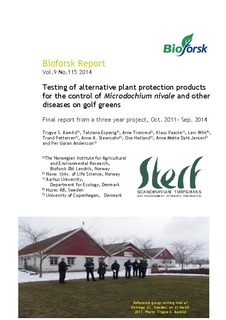| dc.description.abstract | This report presents results from a project testing Turf G+/WPG (fungal products containing Gliocladium catenulatum) and Turf S+/WPS (bacterial products containing Streptomyces spp.), both from Interagro BIOS AB, and Vacciplant (seaweed product containing laminarine) from Nordisk Alkali AB, for the control of Microdochium nivale and other diseases on golf greens. Five field trials were carried out in Denmark, Sweden and Norway from October 2011 to September 2014, and Turf G+/WPG and Turf S+ were tested also in vitro. None of the test-products gave any consistent disease control in the field trials. A significant reduction in Microdochium nivale from 3 % of plot area on untreated plots to 2 % on treated plots was seen in one trial, but this was considered to be of little practical relevance. In all other trials with more severe attacks of Microdochium nivale, only the fungicide control treatment showed a significant reduction in disease compared with the untreated control. On average for all field trials over three years, the higher rate of Vacciplant, the combination of Turf G+/WPG and Turf S+/WPS, and the fungicide treatment gave, in turn, 22, 24 and 87 % less microdochium patch in the fall, but among these, only the effect of fungicide was significant. The effects of the biological products on pink or gray (Typhula incarnata) snow mold after snow melt were even smaller. In the in vitro trials, Turf S+ provided good control of Microdochium nivale at 6 and 16 ̊C, but Turf G+/WPG was effective only at the higher temperature. However, since these results could not be repeated under field conditions, we have to conclude that none of the test products represent any real alternative to fungicides for control of M. nivale or other diseases on Scandinavian golf courses. | nb_NO |
